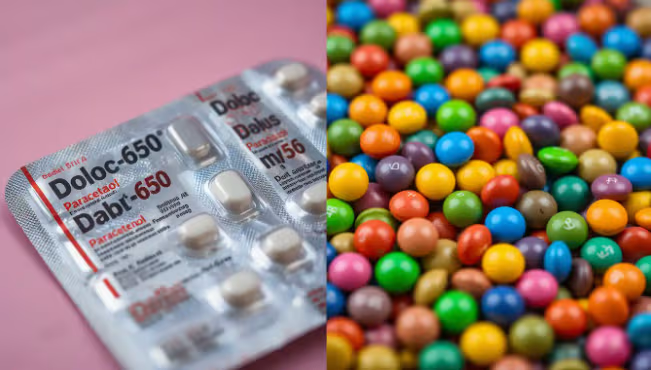Over the past few years, India has witnessed a quiet yet widespread surge in the consumption of Dolo 650, a popular paracetamol brand that became a household name during the COVID-19 pandemic. Once viewed as a standard fever and pain reliever, Dolo 650 is now being casually consumed by many — sometimes with little thought, often without prescriptions. This growing trend has raised serious concerns among healthcare professionals who fear that self-medication and over-reliance on painkillers could have long-term consequences.
The Rise of the “Dolo Craze”
The popularity of Dolo 650 spiked during the COVID-19 pandemic, especially during India’s second wave in 2021. With fever being one of the primary symptoms, paracetamol — especially Dolo 650 — was widely recommended by doctors and health ministries. Its availability, affordability, and strong branding made it the go-to medication for millions.
According to market analytics firm IQVIA, Dolo 650 sales crossed ₹567 crore in 2021 alone, making it the top-selling paracetamol brand in India. The brand’s manufacturer, Micro Labs, became a household name virtually overnight.
But what started as a pandemic necessity has now evolved into a culture of casual consumption, where people reach for a Dolo at the slightest discomfort — headaches, body aches, hangovers, or even before long meetings.
Casual Use Now Commonplace
In interviews conducted across urban and semi-urban centers, several individuals admitted to keeping Dolo in their bags, wallets, or kitchen drawers — not as emergency medication, but as a routine fixer. “It’s just Dolo. It’s safe,” said 29-year-old Arjun Mehta, an IT professional in Bengaluru. “If I have a slight fever or even a sore back, I pop one and continue with my day.”

This mindset is increasingly common among students, office-goers, and even homemakers. The drug’s perception as “harmless” is driving its misuse.
What Doctors Say: “Not Just a Candy”
Doctors across India are beginning to speak out about the trend. Many are concerned that repeated self-medication, especially without understanding the dosage, can cause serious internal damage.
“Paracetamol is generally safe in prescribed doses,” says Dr. Ritu Sharma, a general physician in Delhi. “But when people take it frequently — say three to four times a week without need — it can stress the liver. Long-term misuse can lead to liver toxicity, even failure.”
Dr. Sanjay Kulkarni, a pharmacologist at Mumbai’s KEM Hospital, notes that most people don’t know the cumulative limits of paracetamol. “The safe daily limit is around 3,000 to 4,000 mg for adults. But if you’re taking Dolo (which contains 650 mg) repeatedly or mixing it with other medications that contain paracetamol, you can exceed this threshold quickly.”
Hidden Dangers of Self-Medication
Here are some of the lesser-known risks of frequent and casual Dolo 650 use:
- Liver Damage: The liver processes paracetamol. High doses over time can lead to liver inflammation, scarring, or even acute liver failure.
- Masking Underlying Conditions: Regular use may suppress symptoms temporarily while the root cause remains undiagnosed.
- Overdose Risk: When combined with alcohol or other paracetamol-based medications, the risk of overdose increases.
- Delayed Medical Attention: Self-treatment might delay timely professional intervention.
The Role of Social Media and Memes
The Dolo 650 phenomenon didn’t rise in isolation. It was fueled heavily by social media. During the pandemic, memes and jokes about Dolo became viral. From “Dolo saves India” to “No vaccine, just Dolo,” humor helped people cope with stress, but it also contributed to the normalization of the pill.
Even now, Twitter (now X), Instagram, and WhatsApp are filled with Dolo-related content, often portraying it as a wonder drug. This, say experts, has added to the psychological reassurance that Dolo is “safe no matter what.”
Pharma Industry and Ethical Concerns
In early 2022, Micro Labs, the manufacturer of Dolo 650, was investigated by Indian tax authorities for allegedly spending over ₹1,000 crore on marketing and doctor incentives — raising questions about ethical promotions during the pandemic.
Although the company has denied wrongdoing, critics argue that such aggressive marketing created a pseudo-brand loyalty among both doctors and patients, pushing Dolo ahead of other generic paracetamols.
What You Should Do Instead
Doctors urge the public to treat Dolo 650 — and any medicine — with caution. Here’s what they recommend:
- Consult Before Use: Even for a common fever or headache, consult a doctor if symptoms persist beyond 24-48 hours.
- Avoid Routine Popping: Don’t use Dolo as a preventive or a crutch.
- Check Other Medications: Many cold and flu medicines also contain paracetamol. Avoid double-dosing unknowingly.
- Be Aware of Dosage: Adults should not exceed 4,000 mg per day. Children need even lower doses.
Government and Medical Bodies Respond
Recognizing the growing trend of self-medication, the Indian Medical Association (IMA) recently issued guidelines urging people not to use OTC drugs without proper advice.
The National Medical Commission (NMC) is also exploring tighter controls on advertising and prescription habits around widely used drugs like paracetamol. Public health awareness campaigns are expected in the coming months.
Final Thoughts: Respect the Pill
The rise of Dolo 650 as a cultural icon is both fascinating and cautionary. While it has undoubtedly helped millions manage fever and pain during a national crisis, its overuse and misuse could lead to a silent epidemic of liver damage and diagnostic delays.
As Dr. Sharma puts it, “Just because a medicine is common doesn’t mean it’s harmless. Respect Dolo. Use it right.”
Also Read
Understanding Diabetes: Causes, Symptoms, and How to Manage It Effectively
References
The Hindu – Dolo-650: How this common painkiller became ubiquitous during COVID-19
India Today – Dolo 650 becomes India’s favourite tablet during Covid-19

Add a Comment